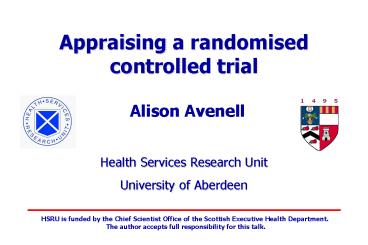Appraising a randomised controlled trial - PowerPoint PPT Presentation
1 / 30
Title:
Appraising a randomised controlled trial
Description:
Critical appraisal skills are important to analyse, interpret ... the extent to which systematic error (bias) is minimised in a clinical study. What is quality? ... – PowerPoint PPT presentation
Number of Views:196
Avg rating:3.0/5.0
Title: Appraising a randomised controlled trial
1
Appraising a randomised controlled trial
- Alison Avenell
2
Why critically appraise?
- Methodological quality of trials may vary
- Trials may be biased
- Critical appraisal skills are important to
analyse, interpret and use clinical information
and research findings
3
CRITICAL APPRAISAL
FIND
USE
APPRAISE
4
- What do we mean by quality of a study?
5
Trial quality
- The quality of a trial is the extent to which
its design and conduct are likely to prevent bias - Variation in quality might explain variation in
results
6
Quality assessment of studies
- Quality assessment refers to the internal
validity of a study - High quality studies are more likely to yield
valid information
7
Internal validity
- the extent to which systematic error (bias) is
minimised in a clinical study
8
What is quality?
- ...the confidence that the trial design,
conduct and analysis has minimized or avoided
biases in its treatment comparisons - (Moher er al, Controlled Clin Trials 1995 16
62-73)
9
Potential sources of bias
- Selection bias
- Performance bias
- Detection bias
- Attrition bias
10
Selection bias
- Systematic differences between intervention
groups - Bias in the way intervention groups are assembled
(biases are likely to occur when participants
receiving treatment are chosen by investigators)
11
Randomisation
INTERVENTION
POPULATION
NO INTERVENTION/PLACEBO
RANDOMISED CONTROLLED TRIAL
12
Randomisation
- Generation of allocation sequences
- Ideally resulting sequence is completely
unpredictable - Inadequate if sequence is predictable
13
Concealment
- Concealment of allocation sequence
- Adequate if patients and investigators cannot
foresee assignment - Inadequate if both parties can foresee assignment
14
Performance bias
- Systematic differences in the care provided apart
from the intervention being evaluated - Contamination and co-intervention can affect
study results - Solution blinding
15
Detection bias
- Systematic differences in outcome assessment
- The investigator assessing the outcomes of a
trial should be blinded to whether the
participants have been in the intervention or
control group - Solution blinding
16
Detection bias blinding
- Single blinding of patients
- Double care provider also blinding
- Triple outcome assessors also blind
- Quadruple analyst also blind
17
- Concealment
- is not the same
- as blinding!!
18
Attrition bias
- Differences between groups in the numbers of
withdrawals/dropouts - Jeopardise comparability of groups
19
Intention-to-treat analysis
- All participants are included in the arm to which
they were allocated, whether or not they received
(or completed) the intervention given to that
arm. Intention-to-treat analysis prevents bias
caused by the loss of participants, which may
disrupt the baseline equivalence established by
randomisation - (The Cochrane Library Handbook glossary)
20
Consolidated standards of reporting trials
(CONSORT)
- Ideally the report of a RCT needs to convey
relevant information concerning the design,
conduct, analysis, and generalisability of the
trial. This information should provide the reader
with the ability to make informed judgements
regarding the internal and external validity of
the trial. - (Begg, JAMA, 1996)
- http//www.consort-statement.org/
21
STUDY QUESTION
- Was the study addressing a clearly focused
question? - Participants/intervention/outcomes?
- Does it make sense?
- Prior hypothesis?
22
TREATMENT ALLOCATION
- Was assignment/allocation to treatment groups
randomised? - Method of randomisation?
- Allocation concealed?
- Balance between treatment groups?
23
INTERVENTION
- Were the intervention groups similar at the start
of the study? - Were the participants treated identically in the
different groups? - Demographic characteristics?
- Severity, co-morbidity, prognosis?
- Treatment regimens described?
- Co-interventions?
24
OUTCOMES
- Clinically relevant outcomes reported?
- - Which outcomes?
- Clinical outcomes/patient-relevant
outcomes/surrogate outcomes? - - How measured?
- Blind, reproducible assessment?
25
ASSESSMENT
- Were all participants who entered the trial
accounted for at the end? - Withdrawals/dropouts after trial entry?
- Were participants analysed in the groups in which
they were originally randomised?
26
FOLLOW-UP
- Duration of follow-up?
- Sufficient to detect all important outcomes?
27
RESULTS
- Appropriate statistical methods?
- - Prior hypothesis-post hoc findings?
- - Adjustment for prognostic variables?
- Main results of the study?
- - How large is the treatment effect?
- - Statistical and clinical significance
reported?
28
STATISTICAL AND CLINICAL SIGNIFICANCE
- Sample size - to detect clinically important
difference in outcome - Type I error (or false positive) results show a
difference between groups when in fact no such
difference exists - Type II error (of false negative) results fail
to detect a difference between groups which does
actually exist
29
APPLICABILITY (external validity)
- Is study applicable and generalisable to other
settings (your setting)? - Participants similar for demographics, severity,
co-morbidity? - Who was included/excluded?
- Intervention relevant and practical (setting,
cultural/geographical differences)
30
USEFUL REFERENCES
- Greenhalgh T. How to read a paper. Assessing the
methodological quality of published papers. BMJ
1997 315 305-308. - Jadad AR. Randomised Controlled Trials. London
BMJ Books, 1998. - Cochrane Handbook for Systematic Reviews of
Interventions http//www.cochrane.org/resources/ha
ndbook/index.htm































